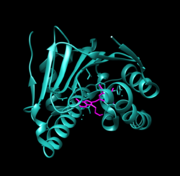Sandbox chaperones
From Proteopedia
| Line 1: | Line 1: | ||
| - | |||
== Chaperones == | == Chaperones == | ||
This page is setup for Paige to build her senior project for OU CHEM 4923 | This page is setup for Paige to build her senior project for OU CHEM 4923 | ||
| + | |||
| + | <Structure load='3hhu' size='350' frame='true' align='right' caption='Human HSP90 3HHU' /> | ||
== Function == | == Function == | ||
The primary function of chaperones is protein folding. They are proteins that assist/chaperone other proteins as they fold or unfold and assemble or disassemble in order to prevent misfolding and unwanted protein aggregation. | The primary function of chaperones is protein folding. They are proteins that assist/chaperone other proteins as they fold or unfold and assemble or disassemble in order to prevent misfolding and unwanted protein aggregation. | ||
| - | Some chaperones function closely with ribosomes in order to help fold newly made proteins, sometimes co-translationally. However, most proteins will fold spontaneously without the help of a chaperone. Chaperones become necessary for most proteins only when the intracellular environment becomes too crowded, thus increasing the chances of protein aggregation unless aided by a chaperone. | + | Some chaperones function closely with ribosomes in order to help fold newly made proteins, sometimes co-translationally. However, most proteins will fold spontaneously without the help of a chaperone. Chaperones become necessary for most proteins only when the intracellular environment becomes too crowded, thus increasing the chances of protein aggregation unless aided by a chaperone. |
| - | + | Many chaperones are heat shock proteins that are expressed in response to high temperatures or other cellular stresses which impact protein folding. In these environments chaperones function to prevent or correct damage caused by misfolding and to prevent unwanted protein aggregation, which is more likely to happen when proteins are denatured by stress. Some heat shock protein chaperones are present at low to moderate levels in virtually all organisms at all times in order to help in essential protein maintenance. <ref>Ellis, R.J. and van der Vies, S.M. (1991). "Molecular chaperones". Annual Review of Biochemistry 60: 321–47</ref> | |
| - | Many chaperones are heat shock proteins that are expressed in response to high temperatures or other cellular stresses which impact protein folding. In these environments chaperones function to prevent or correct damage caused by misfolding and to prevent unwanted protein aggregation, which is more likely to happen when proteins are denatured by stress. Some heat shock protein chaperones are present at low to moderate levels in virtually all organisms at all times in order to help in essential protein maintenance. | + | |
| - | + | ||
| - | < | + | |
| - | + | ||
| - | + | ||
== Energetics == | == Energetics == | ||
| Line 22: | Line 18: | ||
[[Image:1uym.png|thumb|1UYM]] | [[Image:1uym.png|thumb|1UYM]] | ||
| + | |||
| + | Because many client proteins of the chaperone protein HSP90 are involved in cellular growth, inhibition of the ATPase activity of HSP90 is a potential strategy for the treatment of cancers. A specific example of this is in human HSP90 protein 1UYM. A ligand called PU3 is a purine based inhibitor that has been developed using 1UYM for the potential purpose as an anticancer drug targeted at HSP90 proteins. PU3 tightly binds the ATP binding site of 1UYM and causes downregulation on it's client proteins. This results in misfolded proteins accumulating in the cell and eventual cell death. <ref>DOI: 10.1016/j.chembiol.2004.03.033</ref> | ||
== References == | == References == | ||
<references/> | <references/> | ||
Revision as of 13:33, 17 December 2015
Contents |
Chaperones
This page is setup for Paige to build her senior project for OU CHEM 4923
|
Function
The primary function of chaperones is protein folding. They are proteins that assist/chaperone other proteins as they fold or unfold and assemble or disassemble in order to prevent misfolding and unwanted protein aggregation. Some chaperones function closely with ribosomes in order to help fold newly made proteins, sometimes co-translationally. However, most proteins will fold spontaneously without the help of a chaperone. Chaperones become necessary for most proteins only when the intracellular environment becomes too crowded, thus increasing the chances of protein aggregation unless aided by a chaperone. Many chaperones are heat shock proteins that are expressed in response to high temperatures or other cellular stresses which impact protein folding. In these environments chaperones function to prevent or correct damage caused by misfolding and to prevent unwanted protein aggregation, which is more likely to happen when proteins are denatured by stress. Some heat shock protein chaperones are present at low to moderate levels in virtually all organisms at all times in order to help in essential protein maintenance. [1]
Energetics
Structural highlights
Disease
Because many client proteins of the chaperone protein HSP90 are involved in cellular growth, inhibition of the ATPase activity of HSP90 is a potential strategy for the treatment of cancers. A specific example of this is in human HSP90 protein 1UYM. A ligand called PU3 is a purine based inhibitor that has been developed using 1UYM for the potential purpose as an anticancer drug targeted at HSP90 proteins. PU3 tightly binds the ATP binding site of 1UYM and causes downregulation on it's client proteins. This results in misfolded proteins accumulating in the cell and eventual cell death. [2]
References
- ↑ Ellis, R.J. and van der Vies, S.M. (1991). "Molecular chaperones". Annual Review of Biochemistry 60: 321–47
- ↑ Wright L, Barril X, Dymock B, Sheridan L, Surgenor A, Beswick M, Drysdale M, Collier A, Massey A, Davies N, Fink A, Fromont C, Aherne W, Boxall K, Sharp S, Workman P, Hubbard RE. Structure-activity relationships in purine-based inhibitor binding to HSP90 isoforms. Chem Biol. 2004 Jun;11(6):775-85. PMID:15217611 doi:http://dx.doi.org/10.1016/j.chembiol.2004.03.033

